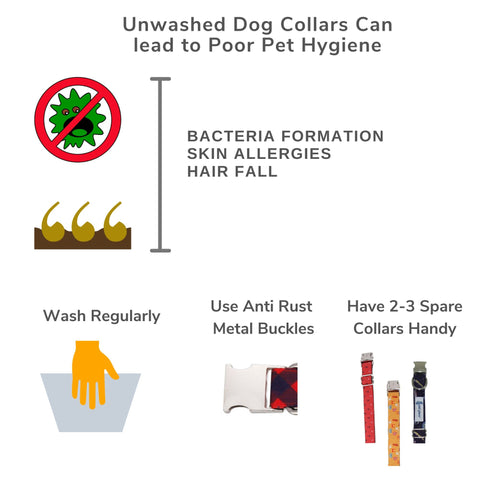A Dog Collar isn't just a pretty accessory for your dog. It is an important identification mark for all dog’s pets and strays alike. It also is a must have accessory to attach a leash on your pet especially in busy urban areas.
Choosing a right collar for a puppy or even a grown up dog is very crucial. You will definitely want your dog to have it’s very first experience of wearing a collar, a good one.
If your dog is still a puppy and is yet to complete all of it’s shots, it is recommended that it remains indoors and away from vulnerable exposure to the outer environment.
There are many factors you may want to consider when deciding on a collar for a pup or an adult dog. Like the type of collar, material size etc, will help you determine which collar is best for your dog.
With a little bit of right information you can make a good choice.
Before we proceed, let’s understand essential parts of a dog collar hardware.

A dog collar is made up of Buckles, Adjuster and a D-ring. Buckles hold the collar together, adjusters assist in adjusting the size of the collar and D-ring enables you to attach a leash to the collar.
Choose a Breakaway Collar in early days
- Firstly, if your dog is a puppy, it is going to remain indoors in early days, it is recommended that you consider buying your pup a reliable Breakaway
 Collar. Breakaway Collar, (commonly known as Cat Collars) as the name suggests, are designed to snap open easily to avoid any risk of accidental strangulation.
Collar. Breakaway Collar, (commonly known as Cat Collars) as the name suggests, are designed to snap open easily to avoid any risk of accidental strangulation.
- This is very important if your puppy is going to be left alone unsupervised for a longer period.
Safe & Easy to adjust Buckles
As your puppy grows beyond 90 days period, it will be ready for leash walking. Depending on the breed, you need to ensure that the puppy collar you choose has strong, safe and reliable Buckles & D-ring.
Buckles, Adjusters & D Ring are a critical part of dog collar hardware that often gets ignored. Inferior quality buckles can snap open or even break.
- Further poor attention to stitching can lead to opening of the collar itself, which can endanger your puppy on a busy road.
- Use of reliable high grade metal dog collars buckles or superior quality plastic buckles shall provide necessary strength and safety.
Selecting the right material
When considering a puppy collar, please be present to your puppy's needs. Select a light weight material as a puppy collar. If your dog is a an adult dog, you can choose between Nylon, Fabric or Leather Collars. Be mindful of the weather in your city before making the choice of the material.
Poor choice of material can cause skin rashes and eventually lead to infections if not attended.

- Avoid using silicon or fancy rubber collars that can be rough on puppies tender skin.
- Softer inner webbing & fabrics with smooth sewing seams will provide much better comfort as compared to metal chain, or leather materials.
- Breathable Fabric Dog Collars are even better, given that it will assist in providing much needed skin & coat care. Though fabric collars are a little more expensive than cheap rubber collars, you will realise it is a better investment given that it is more durable, long lasting & easy on your pet’s skin.
Washable Collars
Using a Washable Dog Collars is very important for your dog's hygiene.

- Collars tend to get dirty and are a breeding ground for bacteria.
- Puppies love to roll and can get naughty when indoors or outdoors. Hence it is very important to choose a puppy collar that is easy to remove and wash and scrub hard.
- Some of Pet Glam’s premium metal buckle collars come with additional rust proof treatment and sustain long rigorous usage.
- Never put a wet or stained collar collar back onto the puppy as this can cause skin irritation & could even lead to an infection. It helps to have a set of 2-3 collars handy, so that your puppy can wear the spare while one is getting dried.
Measure Their Neck
Before you make a purchase, measure the circumference of your dog's neck ( in cms/ inches) with a soft tape measure.
- Measuring when standing up is advisable as against when they are sitting.
- A collar should fit snug around your puppy’s neck and yet leave enough room to fit two fingers between the collar and it’s neck.
Making your puppy comfortable with a collar is one of the basic training you will impart as a pet parent. Whether you decide to leave the collar full time or remove it occasionally, you can train your puppy to indicate that it’s time to go for a walk.
If your puppy is trained to get comfortable with a collar and is eager to put it on before a walk, it will go a long way in your dogs’ behavioral training.








 Collar. Breakaway Collar, (commonly known as Cat Collars) as the name suggests, are designed to snap open easily to avoid any risk of accidental strangulation.
Collar. Breakaway Collar, (commonly known as Cat Collars) as the name suggests, are designed to snap open easily to avoid any risk of accidental strangulation. 

